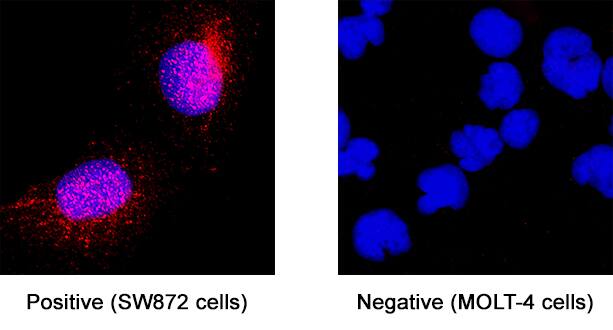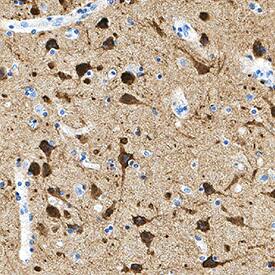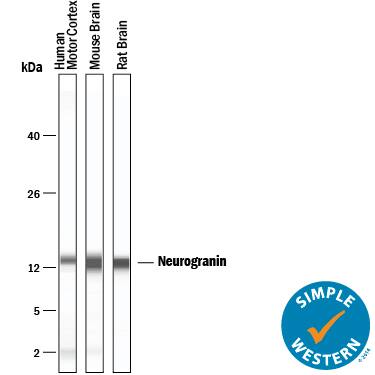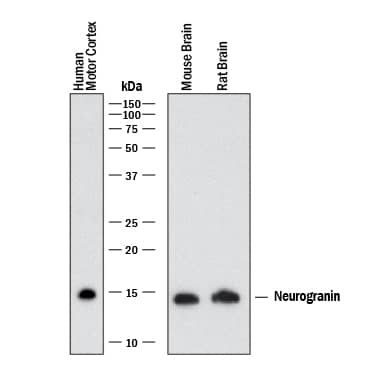Human Neurogranin Antibody
R&D Systems, part of Bio-Techne | Catalog # MAB79471

Key Product Details
Species Reactivity
Human
Applications
Immunocytochemistry, Immunohistochemistry, Simple Western, Western Blot
Label
Unconjugated
Antibody Source
Monoclonal Mouse IgG2B Clone # 1034242
Product Specifications
Immunogen
E. coli-derived recombinant human Neurogranin
Met1-Asp78
Accession # Q92686
Met1-Asp78
Accession # Q92686
Specificity
Detects human Neurogranin in direct ELISAs.
Clonality
Monoclonal
Host
Mouse
Isotype
IgG2B
Scientific Data Images for Human Neurogranin Antibody
Detection of Human, Mouse, and Rat Neurogranin by Western Blot.
Western blot shows lysates of human brain (motor cortex), mouse brain, and rat brain. PVDF membrane was probed with 2 µg/mL of Mouse Anti-Human Neurogranin Monoclonal Antibody (Catalog # MAB79471) followed by HRP-conjugated Anti-Mouse IgG Secondary Antibody (HAF018). A specific band was detected for Neurogranin at approximately 14-15 kDa (as indicated). This experiment was conducted under reducing conditions and using Western Blot Buffer Group 1.Neurogranin in SW480 Human Cell Line .
Neurogranin was detected in immersion fixed SW480 human liposarcoma cell line (positive staining) and MOLT-4 human acute lymphoblastic leukemia cell line using Mouse Anti-Human Neurogranin Monoclonal Antibody (Catalog # MAB79471) at 8 µg/mL for 3 hours at room temperature. Cells were stained using the NorthernLights™ 557-conjugated Anti-Mouse IgG Secondary Antibody (red; NL007) and counterstained with DAPI (blue). Specific staining was localized to cytoplasm. Staining is performed using our protocol for Fluorescent ICC Staining of Non-adherent Cells.Neurogranin in Human Brain (Cortex).
Neurogranin was detected in immersion fixed paraffin-embedded sections of human brain (cortex) using Mouse Anti-Human Neurogranin Monoclonal Antibody (Catalog # MAB79471) at 5 µg/mL for 1 hour at room temperature followed by incubation with the Anti-Mouse IgG VisUCyte™ HRP Polymer Antibody (Catalog # VC001). Before incubation with the primary antibody, tissue was subjected to heat-induced epitope retrieval using Antigen Retrieval Reagent-Basic (Catalog # CTS013). Tissue was stained using DAB (brown) and counterstained with hematoxylin (blue). Specific staining was localized to cytoplasm in neurons. View our protocol for IHC Staining with VisUCyte HRP Polymer Detection Reagents.Applications for Human Neurogranin Antibody
Application
Recommended Usage
Immunocytochemistry
8-25 µg/mL
Sample: Immersion fixed SW480 human liposarcoma cell line
Sample: Immersion fixed SW480 human liposarcoma cell line
Immunohistochemistry
5-25 µg/mL
Sample: Immersion fixed paraffin-embedded sections of human brain (cortex)
Sample: Immersion fixed paraffin-embedded sections of human brain (cortex)
Simple Western
10 µg/mL
Sample: Human brain (motor cortex), mouse brain, and rat brain
Sample: Human brain (motor cortex), mouse brain, and rat brain
Western Blot
2 µg/mL
Sample: Human brain (motor cortex), mouse brain, and rat brain
Sample: Human brain (motor cortex), mouse brain, and rat brain
Reviewed Applications
Read 2 reviews rated 5 using MAB79471 in the following applications:
Formulation, Preparation, and Storage
Purification
Protein A or G purified from hybridoma culture supernatant
Reconstitution
Reconstitute at 0.5 mg/mL in sterile PBS. For liquid material, refer to CoA for concentration.
Formulation
Lyophilized from a 0.2 μm filtered solution in PBS with Trehalose. *Small pack size (SP) is supplied either lyophilized or as a 0.2 µm filtered solution in PBS.
Shipping
Lyophilized product is shipped at ambient temperature. Liquid small pack size (-SP) is shipped with polar packs. Upon receipt, store immediately at the temperature recommended below.
Stability & Storage
Use a manual defrost freezer and avoid repeated freeze-thaw cycles.
- 12 months from date of receipt, -20 to -70 °C as supplied.
- 1 month, 2 to 8 °C under sterile conditions after reconstitution.
- 6 months, -20 to -70 °C under sterile conditions after reconstitution.
Background: Neurogranin
Alternate Names
hng, NRGN, RC3
Gene Symbol
NRGN
UniProt
Additional Neurogranin Products
Product Documents for Human Neurogranin Antibody
Product Specific Notices for Human Neurogranin Antibody
For research use only
